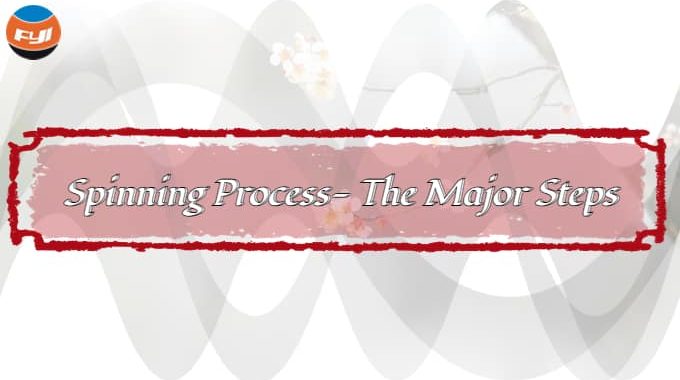
Spinning Process- The Major Steps
Spinning is a very ancient activity, and people have understood how to spin small fibers into long threads, which are subsequently weaved into cloth since prehistoric times. Spinning process, in general, is the act of twisting animal or vegetable fibers to make a continuous and infinitely expanding thread ideal for weaving.
Cotton spinning is the technique of spinning random short fibers such as raw cotton into continuous cotton yarn or cotton mixed yarn. Spinning is the process of transforming disordered fibers into fiber aggregates. Compressed cotton bales enter the cotton spinning mill as raw cotton. The fibers are blocky and disorganized, with different contaminants and flaws. As a result, it is important to loosen first and then assemble when spinning, that is, to break the superfluous link between fibers and remove them. Impurity flaws are organized axially to generate slivers of the desired thickness, which are then appropriately twisted to form cotton yarn.
Cleaning, carding, combing, drawing, roving, and spun yarn are the major steps in the spinning process. Each stage in the spinning process is described in detail below:
Contents
Cleaning process
The cleaning procedure removes the majority of the contaminants, flaws, and short fibers in raw cotton that are not appropriate for spinning. It is to take the raw materials from the cotton bales, combine them equally, open them into little cotton blocks or small cotton bundles, and eliminate any impurities or faults. Cotton layers of varying widths, thicknesses, and weights are then combined and wrapped into laps.
The main task of cotton cleaning process
Mixing
The blending of raw cotton entails the blending procedure as well as the blending quality. Cotton bag loose fiber blending, sliver blending, and weight blending are now utilized in spinning. Particular care should be taken to ensure the consistent blending of raw cotton with varying qualities, recycled cotton, and recycled cotton.
The more regular the mixing, the better it is for resolving color differences, color shift, improving uniformity, and lowering the coefficient of variation of single yarn breaking strength. To increase yarn quality, alternative cotton opening and cleaning techniques can be used for raw cotton with considerable differences in impurity concentration, and then blended on the draw frame.
Opening
Opening is required to guarantee that the blended cotton components are thoroughly mixed, that contaminants are eliminated, and that the fibers are single-fibrillated. According to the opening state of the feed material, opening can be classified as free or holding.
1. Unrestricted access
Free opening refers to raw cotton accepting the operation of the opening mechanism in a free condition, which can be further subdivided into free tearing and free blowing.
2. Hold and release
The raw material is fed into the machine in the holding condition while also being impacted by the opening mechanism, a process known as holding and opening. On raw cotton, it may be separated into two action modes: holding and hitting and holding and carding. The results of openness and impurity elimination are more liberated. The opening is robust, but the fiber damage and impurity crushing are more severe than free opening.
The notion of “slow down initially, then quick, progressive opening, and minimum fiber damage” should be followed during the opening process. In the process of impurity removal, impurities that are heavy, relatively large and easily broken, and have low fiber adhesion should be eliminated first in line with the technological principle of “early falling and anti-shattering”.
Machinery involved in the cleaning process:
Cotton opener, cleaning machine, cotton blending machine, lapping machine.
Carding process
Carding is the process of breaking tiny cotton bundles into a single fiber condition by needle surface movement, removing contaminants and non-spinnable short fibers, making the fibers parallel and straight, and ultimately making a sliver Roll into cans.
After cotton cleaning, the fibers in the cotton roll or loose cotton are mostly in the form of loose cotton blocks and cotton bundles, and contain 40% to 50% impurities, the majority of which are small, highly adhesive fibrous impurities (such as broken seeds with fiber, seed scraps, soft seed skin, cotton neps, and so on), so the fiber bundle must be completely decomposed into single fibers, and the fine impurities remaining in it must be removed, so that the fibers
The main tasks of the carding process
- Carding: In order to cause the least amount of damage to the fibers, the feed cotton layer is carded painstakingly and thoroughly to separate the bundled fibers into single fiber states.
- Impurity removal: After adequate fiber separation, completely remove residual impurities and flaws.
- Mixing: In the single fiber state, ensure that the fibers are thoroughly mixed and equally dispersed.
- Slivers: Make uniform slivers to particular specifications and quality standards and store them in sliver cans on a regular basis.
Carding machine
The carding machine is responsible for completing the carding process. The extent to which cotton bundles are split into single fibers on the carding machine is directly proportional to yarn strength and evenness. The effect of its impurity removal influences the nep impurities and evenness of the yarn significantly. The carding machine has the highest noil rate of the carding system’s single machines, and the noil has a particular number of spinnable fibers, therefore the quantity and quality of the carding machine’s noil are directly proportional to the amount of cotton utilized.
Combing process
Before processing cotton, wool, and silk fibers into textiles, the combing process removes contaminants and short filaments in the fibers with a combing machine. When compared to carded textiles, the texture, washability, and durability of the cloth generated by this method are much enhanced.
The main tasks of the combing process
- Impurity removal: clean the fibers of neps, contaminants, and fiber flaws.
- Carding: separates fibers further and excludes short fibers of a specified length.
- Drafting: reducing the thickness of the sliver and enhancing the parallel straightness of the fibers.
- Slivers: Create cotton slivers that fulfill the specifications.
Combing machine
Carding the two ends of a fiber bundle alternately with a machine equipped with carding needles on the surface to eliminate inappropriate short fibers. The combing process improves the uniformity of the fiber length, separates kinked fibers into a single condition, and removes contaminants and fiber knots (neps, wool grains, hemp grains, cocoon skin, etc.) contained in the raw materials. The raw material’s spinnability has substantially enhanced. As a result, the combing technique is commonly utilized in the manufacture of fine count and high-quality yarns. The woven fabric features crisp lines, minimal streaks and shadows, and a consistent surface due to the combed yarn’s uniform dryness, smoothness, and greatly enhanced strength.
Drawing process
In the previous procedure, the fiber material was opened and carded, resulting in a continuous strip-shaped semi-finished product known as a sliver, also known as a raw sliver. After preliminary orientation and straightening of the fibers, the raw sliver generated by the carding machine has the preliminary shape of a sliver. The unevenness of the carded sliver, on the other hand, is quite significant, and the fiber organization in the carded sliver is disorderly, with most of the fibers in a hook form. If this carded sliver is spun immediately into spun yarn, the spun yarn will be of poor quality. As a result, the carded slivers must be mixed before further spinning to improve evenness and fiber condition.
The main tasks of the drawing process
(1) Combining: To produce a sliver, feed 6-8 slivers into the drawing frame. The unequal length of the sliver can be addressed since the thick and thin regions of each sliver have the possibility to overlap each other. Rate. The raw sliver has a weight unevenness of roughly 4.0%, and the cooked sliver should have a weight unevenness of less than 1% after merging.
(2) Drafting: the sliver is stretched and thinned to the original level, and at the same time, the state of the fiber is improved through drafting, so that the hook and crimped fiber can be further straightened and paralleled, and the small cotton bundle is further separated into single fibers. By changing the drafting ratio, the quantification of the cooked sliver can be effectively controlled to ensure that the weight deviation and weight unevenness of the spun yarn meet the standard.
(3) Mixing: The repeated merging process is used to further realize the mixing of single fibers, ensuring that the mixed cotton composition of the sliver is homogeneous and the yarn quality is stable. Because different fibers have distinct dyeing qualities, slivers composed of different fibers can be blended on the draw frame to thoroughly mix the various fibers. A good way to create color variation, especially when chemical fiber and cotton are used.
(4) Sliver: Place the sliver created by the drawing frame in a regular circle in the sliver tube so that it may be transferred and stored for the next operation.
Roving process
The primary goal of the roving process is to give the sliver a proper twist or false twist by twisting or twisting, so that the roving has enough strength to survive the stress of winding and unwinding and is advantageous to the drafting process on the spinning frame. Wind the roving into a certain package form to enable transportation and storage, match the criteria of the spinning frame for the feeding form, and improve the spinning frame’s efficiency.
Primary mission
- Drafting: the sliver is drawn and thinned until it is the size of a roving.
- Twisting: To increase the strength of the roving, add a twist to it.
- Winding: Thread the bobbin with the twisted roving.
Spinning process
The spinning process is the final step in the spinning production process. It is to spin the roving into a spun yarn with a specific unique number that fulfills the quality standard or client needs and is suitable for twisting, weaving, or knitting. The spinning frame is the main piece of mechanical equipment.
Spun yarn serves the following purposes
- Extend the yarn to boost the yarn’s package capacity and the succeeding process’s production efficiency.
- Remove faults and impurities from the yarn to increase its quality and strength.
The main duties of the spinning process
- Drafting: the feed roving or sliver is equally stretched and thinned to the appropriate particular number by the spun yarn.
- Twisting: Appropriate twist is given to the pulled strands to give the yarn physical and mechanical attributes like strength, elasticity, luster, and hand feel.
- Winding and forming: To enable transportation, storage, and future processing, the spun yarn is coiled on the bobbin according to specific shaping requirements.
Comments are closed.





I really like the way that you have explained more about this spinning process.
Nice content, informative and fantastic design, as well as sharing nice material with good thoughts and concepts, loads of great knowledge and inspiration, both of which I require, thank you for providing such useful information.
I’ve never seen something like this before. The information is quite intriguing.
Every article on this blog is meticulously crafted, ensuring a high-quality reading experience.